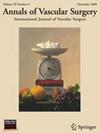Acute Limb Ischemia in Patients on Veno-Arterial Extracorporeal Membrane Oxygenation (VA-ECMO) Support: A Ten-Year Single-Center Experience
IF 1.4
4区 医学
Q3 PERIPHERAL VASCULAR DISEASE
引用次数: 0
Abstract
Background
Veno-arterial extracorporeal membrane oxygenation (VA-ECMO) has been increasingly utilized as a life-saving modality in patients with cardiopulmonary compromise. Acute limb ischemia (ALI) has been reported when the femoral artery was accessed, and it was associated with higher mortality in patients on extracorporeal membrane oxygenation (ECMO). However, prior studies were limited by small sample size and the lack of long-term follow-up. We aimed to investigate the predictors of ALI in ECMO and the effect of ALI on long-term mortality.
Methods
Retrospective institutional chart review was performed. Patients who underwent VA-ECMO (Jan/2008-Jan/2018) were identified. Primary outcomes were ALI and 4-year mortality. Logistic regression analysis was used to investigate the predictors of ALI. Survival analysis methods were used to examine 4-year mortality.
Results
A total of 377 patients were included. Vascular complications took place in 149 (39.5%) patients. The majority was ALI (107, 75.4%). Eleven patients had limb loss. ALI patients were younger (mean age: 50.2 ± 15.9 vs. 54.1 ± 15.5; P = 0.03), were more likely to have history of peripheral arterial disease (PAD) (7.6% vs. 3.0%; P = 0.047), were less likely to be on aspirin (40.2% vs. 54.4%; P = 0.013), and were more likely to be on vasopressors (97.1% vs. 88.0%; P = 0.007). Arterial cannula size was not associated with ALI so as the concurrent use of ventricular offloading devices (intra-aortic balloon pump or Impella (Abiomed Inc, Dancers, MA)). The use of distal perfusion catheter (DPC) was not protective against ALI in this cohort. However, DPC was associated with less likelihood to require vascular intervention (20.1% vs. 32.0%; P = 0.009). In adjusted analysis, aspirin use was protective against ALI [adjusted odds ratios (aOR) 95% CI: 0.52(0.30 – 0.90); P = 0.018]. The only predictor of ALI was the use of vasopressors [aOR (95% CI): 6.8 (1.5 – 30.4); P = 0.012]. For those who were successfully decannulated, 4-year survival was 65.1% in patients without ALI versus 46.8% in ALI (P = 0.044). After adjusting for potential risk factors, 4-year mortality hazard was significantly higher in patients with ALI [HR: 1.80(1.04 – 3.12); P = 0.035].
Conclusions
Patients requiring ECMO are critically ill. The development of ALI is detrimental to this population. This effect extends beyond the acute period. ALI increased 4-year mortality risk by 80%. The use of DPC did not protect against ALI, but it was associated with less vascular interventions.
静脉-动脉体外膜氧合(VA-ECMO)支持患者的急性肢体缺血:十年单中心经验
目的:在心肺功能受损的患者中,VA-ECMO 作为一种挽救生命的方式已被越来越多地采用。有报道称,当接入股动脉时会出现急性肢体缺血(ALI),这与使用 ECMO 的患者死亡率较高有关。然而,之前的研究受限于样本量小和缺乏长期随访。我们旨在研究 ECMO 患者发生 ALI 的预测因素以及 ALI 对长期死亡率的影响:方法:我们进行了回顾性机构病历审查。确定了接受 VA-ECMO 的患者(2008 年 1 月至 2018 年 1 月)。主要结果为ALI和4年死亡率。逻辑回归分析用于研究ALI的预测因素。采用生存分析方法研究4年死亡率:结果:共纳入 377 名患者。149例(39.5%)患者出现了血管并发症。其中大部分为急性心肌梗死(107例,75.4%)。11名患者肢体缺失。ALI患者更年轻(平均年龄:50.2±15.9 vs 54.1±15.5;p=.03),更有可能有PAD病史(7.6% vs 3.0%;p=.047),服用阿司匹林的可能性更小(40.2% vs 54.4%;p=.013),更有可能使用血管加压药(97.1% vs 88.0%;p=.007)。动脉插管的大小与ALI无关,同时使用心室负荷装置(主动脉内球囊泵或Impella(Abiomed Inc,马萨诸塞州丹佛斯))也与ALI无关。在该队列中,使用远端灌注导管(DPC)对 ALI 没有保护作用。然而,DPC与需要血管介入治疗的可能性降低有关(20.1% vs 32.0%; p=.009)。在调整后的分析中,使用阿司匹林对ALI有保护作用[调整后的几率比(aOR)95%CI:0.52(0.30-0.90); p=.018]。ALI的唯一预测因素是使用血管加压药[aOR(95%CI):6.8 (1.5-30.4);p=.012]。对于成功解痉的患者,无 ALI 患者的四年存活率为 65.1%,而有 ALI 患者的四年存活率为 46.8%(P=0.044)。调整潜在风险因素后,ALI 患者的 4 年死亡率明显更高[HR:1.80(1.04-3.12); p=0.035]:结论:需要接受 ECMO 的患者病情危重。结论:需要 ECMO 的患者病情危重,发生急性肢体缺血对他们不利。这种影响超出了急性期。急性肢体缺血使 4 年死亡风险增加了 80%。使用 DPC 并不能防止 ALI,但却能减少血管干预。
本文章由计算机程序翻译,如有差异,请以英文原文为准。
求助全文
约1分钟内获得全文
求助全文
来源期刊
CiteScore
3.00
自引率
13.30%
发文量
603
审稿时长
50 days
期刊介绍:
Annals of Vascular Surgery, published eight times a year, invites original manuscripts reporting clinical and experimental work in vascular surgery for peer review. Articles may be submitted for the following sections of the journal:
Clinical Research (reports of clinical series, new drug or medical device trials)
Basic Science Research (new investigations, experimental work)
Case Reports (reports on a limited series of patients)
General Reviews (scholarly review of the existing literature on a relevant topic)
Developments in Endovascular and Endoscopic Surgery
Selected Techniques (technical maneuvers)
Historical Notes (interesting vignettes from the early days of vascular surgery)
Editorials/Correspondence

 求助内容:
求助内容: 应助结果提醒方式:
应助结果提醒方式:


